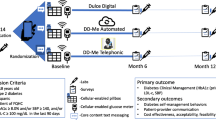Abstract
Mobile health systems aiming to promote adherence may cost-effectively improve the self-management of chronic diseases like diabetes, enhancing the compliance to the medical prescription, encouraging and stimulating patients to adopt healthy life styles and promoting empowerment. This paper presents a strategy for m-health applications in diabetes self-management that is based on automatic generation of feedback messages. A feedback assistant, representing the core of architecture, delivers dynamic and automatically updated text messages set up on clinical guideline and patient’s lifestyle. Based on this strategy, an m-health adherence system was designed, developed and tested in a small-scale exploratory study with T1DM and T2DM patients. The results indicate that the system could be feasible and well accepted and that its usage increased along with adherence to prescriptions during the 4 weeks of the study. A more extensive research is pending to corroborate these outcomes and to establish a clear benefit of the proposed solution.






Similar content being viewed by others
References
Applying Behavior Change Principles to Remote Health Management (2011) A primer and style guide. Intel-GE Care Innovations™, https://www.careinnovations.com/Data/Downloads/Guide_Product/Guide_WhitePaper_Behavior.pdf
Ayres LR, de Baldoni Oliveira A (2014) Adherence and discontinuation of oral hormonal therapy in patients with hormone receptor positive breast cancer. Int J Clin Pharm 36(1):45–54
Brug J, Oenema A, Campbell M (2003) Past, present, and future of computer-tailored nutrition education. Am J Clin Nutr 77(Suppl 4):1028S–1034S
Dayer L, Heldenbrand S, Anderson P, Gubbins PO, Martin BC (2013) Smartphone medication adherence apps: Potential benefits to patients and providers. J Am Pharm Assoc 53(2):172–181
Dolan B (2012) Text messages: the workhorse of mobile health. Mobihealth news, http://mobihealthnews.com/19440/text-messages-the-workhorse-of-mobile-health/
El-Gayar O, Timsina P, Nawar N, Eid W (2013) Mobile applications for diabetes self-management: status and potential. J Diabetes Sci Technol 7(1):247–262
Free C, Phillips G et al (2013) The effectiveness of mobile-health technology-based health behaviour change or disease management interventions for health care consumers: a systematic review. PLoS Medicine. doi:10.1371/journal.pmed.1001362
Funnell M et al (2011) National standards for diabetes self-management education. Diabetes Care 31(supplement 1):S97–S104
Heneghan C, Blacklock C, Perera R et al (2013) Evidence for non-communicable diseases: analysis of Cochrane reviews and randomised trials by World Bank classification. BMJ Open 3:e003298
Johnsrud M, Schafermeyer KW (2002) Measuring adherence and persistence in drug therapy. J Manag Care Pharm 8:204–205
Kreuter MW, Wray RJ (2003) Tailored and targeted health communication: strategies for enhancing information relevance. Am J Health Behav 3:S227–S232
Krishna S, Boren S, Balas E (2009) Healthcare via cell phones: a systematic review. Telemed e-Health 15:231–240
Melillo P, Izzo R, De Luca N, Pecchia L (2012) Heart rate variability and target organ damage in hypertensive patients. BMC Cardiovasc Disord 12:105. doi:10.1186/1471-2261-12-105
METABO project. European Commission. Information Society Technologies Program. Chronic diseases related to metabolic disorders. ICT-26270. http://www.metabo-eu.org
Nundy S, Dick J, Goddu A, Hogan P et al (2012) Using mobile health to support the chronic care model: developing an institutional initiative. IJTA. doi:10.1155/2012/871925
Nundy S, Dick J et al (2013) Developing a behavioral model for mobile phone-based diabetes interventions. Patient Educ Couns 90(1):125–132
Pecchia L, Melillo P, Bracale M (2011) Remote health monitoring of heart failure with data mining via CART method on HRV features. IEEE Trans Biomed Eng 58(3):800–804. doi:10.1109/Tbme.2010.2092776
Planetree and Picker Institute (2008) Practical approaches for building a patient-centered culture. http://www.pickerinstitute.org
Quinn CC, Shardell MD, Terrin ML, Barr EA, Ballew SH, Gruber-Baldini AL (2011) Cluster-randomized trial of a mobile phone personalized behavioral intervention for blood glucose control. Diabetes Care 34(9):1934–1942
Roberts NJ, Kerr SM, Smith SMS (2013) Behavioral interventions associated with smoking cessation in the treatment of tobacco use. Health Serv Insights 6:79–85
Ruggiero L (2000) Helping people with diabetes change behavior: from theory to practice. Diabetes Spectr 13(3):125
Tang T, Funnell M, Brown M, Kurlander J (2010) Self-management support in “real-word” settings: an empowerment-based intervention. Patient Educ Couns 79(2):178–184
Tang T, Funnel M et al (2012) Sustaining short-term improvements over the long-term: results from a 2-year diabetes self-management support (DSMS) intervention. Diabetes Res Clin Pract 95(1):85–92
Tuah NA, Amiel C et al (2011) Transtheoretical model for dietary and physical exercise modification in weight loss management for overweight and obese adults. Cochrane Database Syst Rev. doi:10.1002/14651858
Vervloet M, van Dijk L, Santen-Reestman J et al (2012) SMS reminders improve adherence to oral medication in type 2 diabetes patients who are real time electronically monitored. IJMI 18(9):594–604
World Health Organization (2013) “Prevention and control of non-communicable diseases in the European Region: a progress report,” http://www.euro.who.int/en/health-topics/noncommunicable-diseases/diabetes/publications
Acknowledgments
The authors acknowledge the METABO consortium for their valuable contributions to this work. This project is partially funded by the European Commission (Contract No. 216270) under the 7th Framework Program, Theme ICT-2007.5.1, personal health systems for monitoring and point-of-care diagnostics—personalized monitoring.
Author information
Authors and Affiliations
Corresponding author
Rights and permissions
About this article
Cite this article
Fioravanti, A., Fico, G., Salvi, D. et al. Automatic messaging for improving patients engagement in diabetes management: an exploratory study. Med Biol Eng Comput 53, 1285–1294 (2015). https://doi.org/10.1007/s11517-014-1237-8
Received:
Accepted:
Published:
Issue Date:
DOI: https://doi.org/10.1007/s11517-014-1237-8




